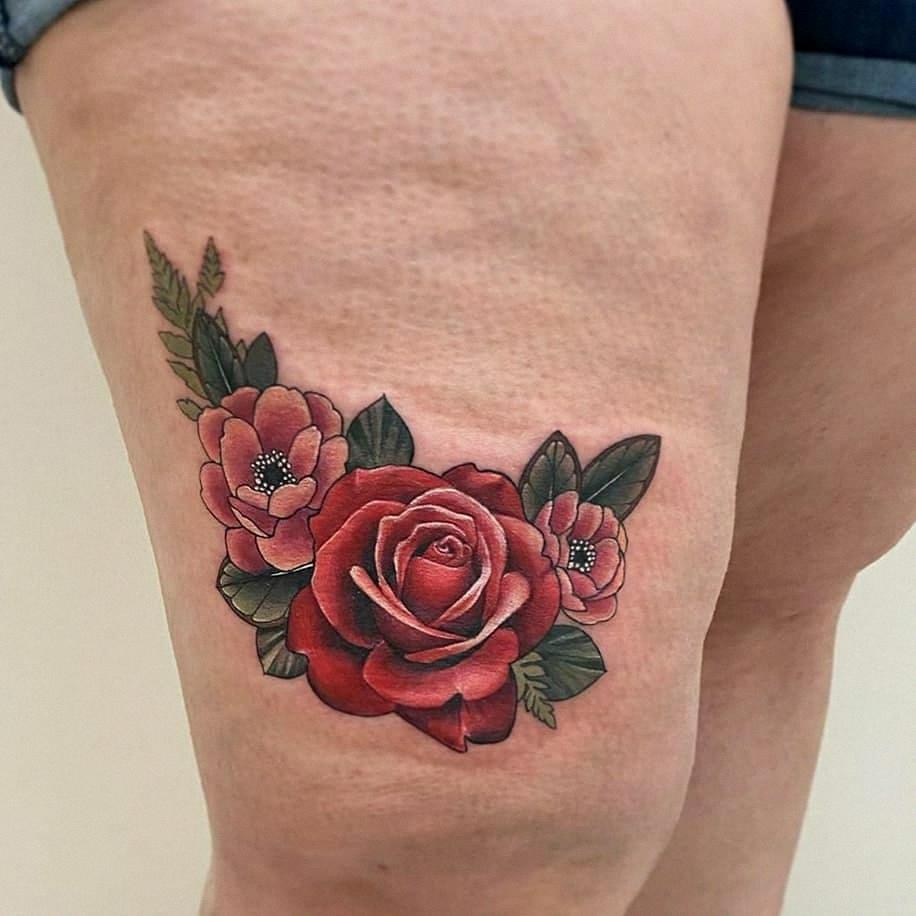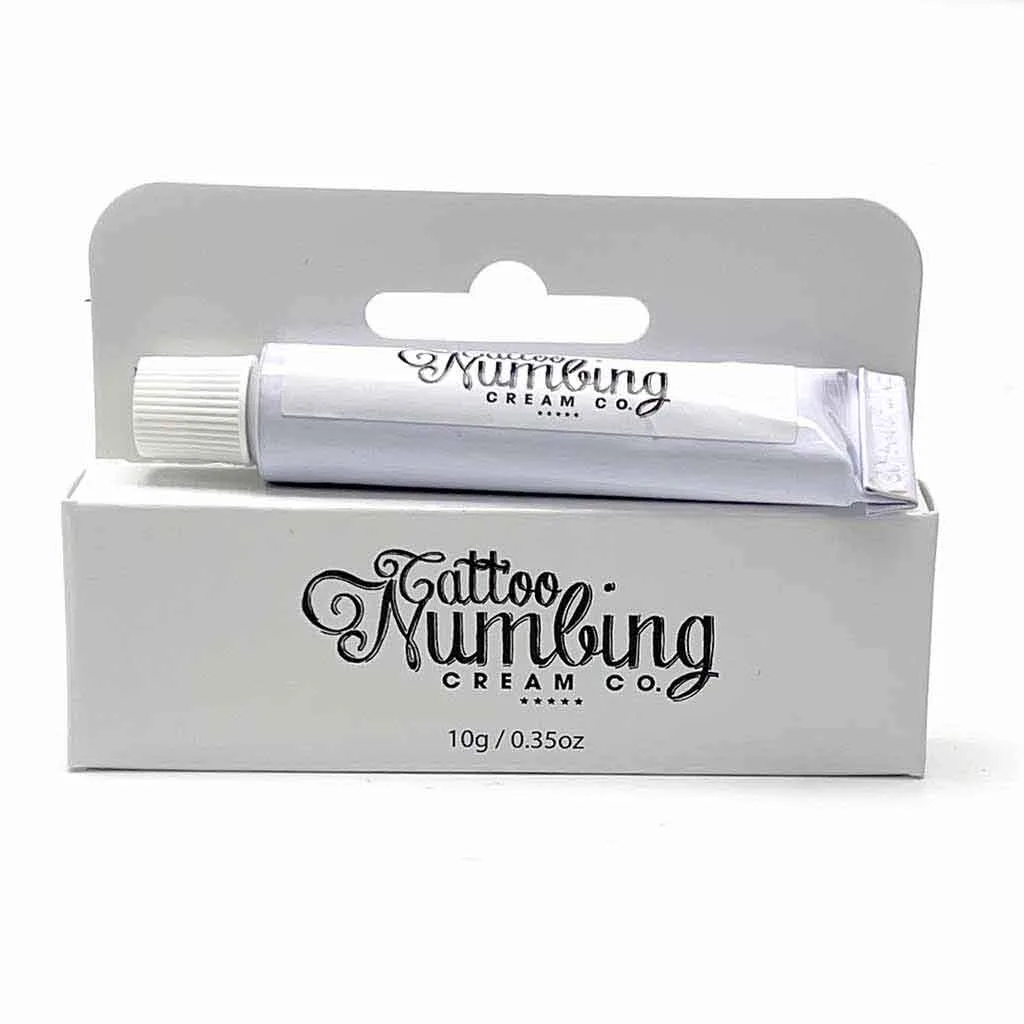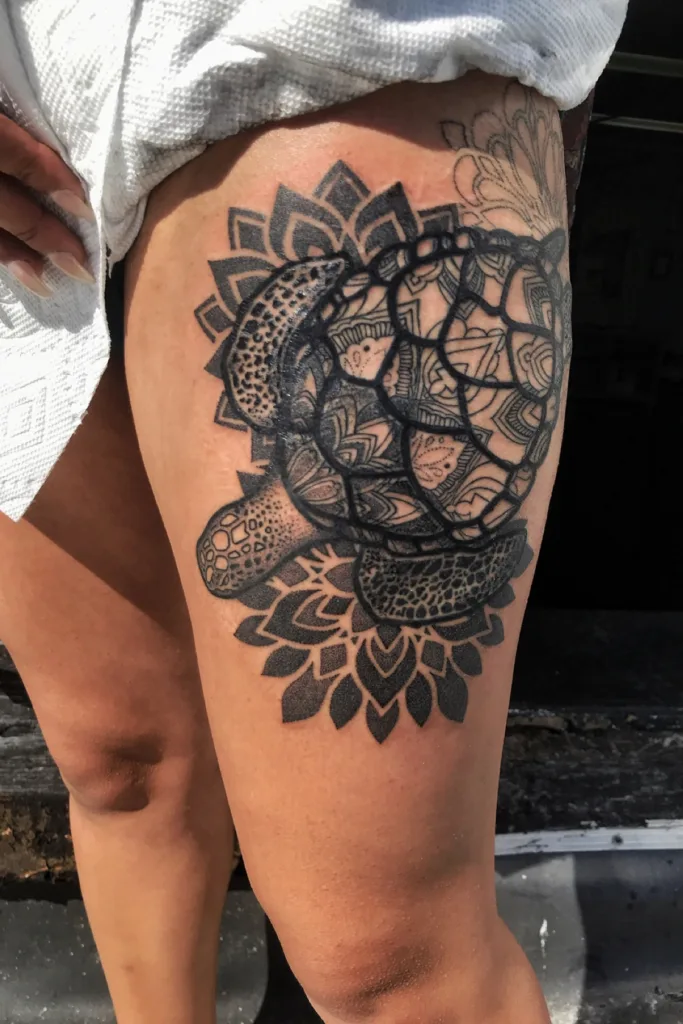Getting a tattoo can be a painful experience, and it’s natural to wonder if certain areas of the body are more or less painful than others. One area that many people consider for a tattoo is the thigh. So, do thigh tattoos hurt? Let’s take a closer look.
First, it’s important to understand that everyone’s pain tolerance is different. What might be excruciating for one person might be manageable for another. That being said, there are a few factors that can influence how much pain you might feel when getting a thigh tattoo.
One factor is the thickness of your skin. Thicker skin tends to be less sensitive to pain, while thinner skin is more sensitive. The skin on the thigh is generally thicker than on other areas of the body, such as the inner wrist or the ribcage. This means that getting a tattoo on your thigh is likely to be less painful than in these more sensitive areas.
Another factor is the location of the tattoo on your thigh. The outer thigh tends to be less painful than the inner thigh, which is more sensitive due to the presence of more nerve endings. If you’re considering a tattoo on your inner thigh, you may want to prepare for a higher level of discomfort.
The size and complexity of the tattoo can also affect the amount of pain you’ll feel. Larger, more intricate tattoos can take longer to complete and require multiple sessions, which can be more uncomfortable than a smaller, simpler design.
Finally, the skill level of your tattoo artist can make a big difference in how much pain you experience. An experienced artist will have a lighter touch and be able to work quickly and efficiently, minimizing your discomfort.
So, do thigh tattoos hurt? The answer is, it depends. While getting a tattoo on your thigh is generally considered to be less painful than some other areas of the body, there are stil factors that can influence how much discomfort you’ll experience. If you’re considering a thigh tattoo, it’s important to choose a skilled artist and prepare yourself mentally and physically for the process. With the right mindset and a little bit of preparation, you can minimize any pain and enjoy the end result of your beautiful new tattoo.
The Least Painful Place to Get a Tattoo
The least painful place to get a tattoo is typically in areas with fewer nerve endings. Some of the most common locations include the outer shoulder, calf, buttocks, and outer arm. These areas are generally considered less sensitive and result in less pain during the tattooing process. However, it’s important to note that pain tolerance can vary greatly from person to person, and some individuals may still experience discomfort in these areas. Additionally, cosmetic physician Stanley Kovak believes that pain is more abut size than location, as larger tattoos tend to be more painful regardless of where they are placed on the body. Ultimately, it’s important to consult with a professional tattoo artist and discuss your pain tolerance and preferred location before getting a tattoo.

Source: reddit.com
The Most Painful Body Part to Tattoo
According to tattoo artists and experienced tattoo enthusiasts, the most painful body part to get a tattoo is the armpit. This is due to the high concentration of nerve endings in that area, which makes it extremely sensitive to pain. Many people also report that getting tattooed on thir rib cage and stomach can be quite painful because of the bony and thin skin in those areas. Other body parts that are known to be very painful to tattoo include the collarbone, elbows, knees, shins, ankles, feet, and the middle of the chest. However, it is important to note that pain tolerance varies from person to person, so what may be extremely painful for one person may not be as painful for another. It is also worth noting that the pain of getting a tattoo is temporary and usually lasts only for the duration of the tattooing process.
Preparing for a Thigh Tattoo
Preparing for a tattoo on your thigh is important to ensure a successful tattoo session and proper healing. Here are some steps to follow to prepare for a tattoo on your thigh:
1. Stay hydrated: Drink plenty of water in the days leading up to your tattoo appointment to keep your skin hydrated and healthy.
2. Shave the area: Shave the area where you will be geting the tattoo to ensure that the tattoo artist has a clean and smooth surface to work on.
3. Keep your skin clean: Wash the area thoroughly with soap and water before your appointment to remove any dirt or oils.
4. Ease up on skin care products: Avoid using any lotions, creams, or other skin care products on the area that will be tattooed for at least 24 hours before your appointment.
5. Avoid sunburn: Avoid exposing the area to direct sunlight or tanning beds for at least a week before your appointment to prevent sunburn.
6. Get a full night’s sleep: Make sure to get a good night’s sleep before your appointment to ensure that you are well-rested and alert during the tattoo session.
7. Don’t show up hungry: Eat a light meal before your appointment to ensure that you have enough energy to sit through the session.
8. Wear a comfortable outfit: Wear loose, comfortable clothing that allows easy access to the area that will be tattooed.
Following these steps will help to ensure a successful tattoo session and proper healing of the tattoo on your thigh.
Tips for Reducing Pain During Tattooing
Getting a tattoo can be a painful experience, but tere are some steps you can take to reduce the discomfort. Firstly, it is important to choose a licensed tattoo artist who has experience and uses proper hygiene practices. Secondly, consider picking a less sensitive body part for your tattoo, such as the upper arm or calf, rather than areas with thinner skin like the ribs or spine. Before your appointment, make sure you get enough sleep and avoid pain relievers as they can thin your blood and increase bleeding. It’s also best to avoid getting a tattoo when you’re sick as your body is already stressed. To help reduce pain during your appointment, stay hydrated and eat a meal beforehand to keep your blood sugar levels steady. Lastly, it’s recommended to avoid alcohol before your appointment, as it can thin your blood and increase the risk of bleeding. By following these tips, you can help make your tattoo experience less painful.
The Effectiveness of Numbing Cream for Tattoos
Yes, numbing cream can work effectively to reduce the pain associated with getting a tattoo. These creams contain a topical anesthetic that numbs the skin’s surface, making it less sensitive to the pain of the needle. Although different creams may have varying strengths and application methods, they are generally applied to the skin 30-60 minutes before the tattooing process begins.
It is important to note that whle numbing creams work for many people, they may not completely eliminate all pain or discomfort. Additionally, individual reactions to numbing creams can vary, and some people may experience adverse reactions such as skin irritation or allergic reactions.
Overall, numbing creams are a safe and popular option for those looking to reduce the pain associated with getting a tattoo. It is recommended to speak with a healthcare professional or tattoo artist before using numbing cream to ensure proper usage and to discuss any potential risks or concerns.

Does Skinny Body Type Affect the Pain of Getting a Tattoo?
When it comes to getting a tattoo, pain is a common concern for many people. While pain levels can vary depending on the individual and the location of the tattoo, body weight can also play a role. Skinny individuals may experience more pain during the tattoo process, as they have less body fat to provie cushioning for the needle. This can make the bones and nerves closer to the surface, making the experience more uncomfortable. Additionally, as the skin of skinny individuals is often tighter and less pliable, it can be more difficult for the tattoo artist to work effectively, which can cause further discomfort. However, it’s important to note that pain levels are subjective and can vary from person to person, regardless of body weight.
How Much Should I Tip My Tattoo Artist?
When it comes to tipping a tattoo artist, there is no hard and fast rule. However, it is generally recommended to tip between 15% to 25% of the total cost of the tattoo. Some artists may have a suggested tip amount, so it’s always a good idea to ask before getting started. It’s also important to consider the quality of the work, the artist’s level of experience, and the ovrall experience you had during the process. If you are pleased with the final result and felt the artist went above and beyond, you may want to tip on the higher end of the spectrum. Ultimately, the decision of how much to tip is up to you, but it is always appreciated to show your gratitude for a job well done.
Understanding Tattoo Pain: What is the Best Option?
It is important to note that pain tolerance is subjective and varies from person to person. However, there are some strategies that can help alleviate tattoo pain. Firstly, it is recommended to eat a proper meal before the appointment to ensure a stable blood sugar level. Additionally, staying hydrated and avoiding alcohol and caffeine can also help reduce pain sensitivity. Local anesthetics, such as lidocaine, can be applied topically to numb the skin before the procedure. Some tattoo artists also recommend taking over-the-counter pain relievers, such as acetaminophen or ibuprofen, before the appointment. It is important to follow the recommended dosage and consult with a healthcare professional if you have any concerns. Ultimately, the best way to manage tattoo pain is to communicate with your tattoo artist and take breaks as needed dring the procedure.
The Cost of a Full Thigh Tattoo
A full thigh tattoo can cost anywhee from $1,000 to $2,000, depending on various factors. The cost of the tattoo largely depends on the size of the design, the complexity of the artwork, and the experience of the tattoo artist. A larger tattoo that covers the entire thigh will generally cost more than a smaller one. Additionally, the level of detail and intricacy of the tattoo design can also impact the price. The use of color or shading can also affect the cost of the tattoo. It is important to do your research and find a reputable tattoo artist who can provide a detailed estimate for the specific design you have in mind.

Sleeping With a Thigh Tattoo
Sleeping with a thigh tattoo can be a bit uncomfortable, especially if the tattoo is still fresh and tender. The frst thing to do is to cover the tattoo with a clean and breathable wrap or bandage to prevent it from sticking to your clothes or bedding. This will also protect the tattoo from bacteria and other harmful elements that can cause infection.
When you’re ready to sleep, it’s important to avoid sleeping on your side or directly on the tattoo, as this can cause irritation and prolong the healing process. Instead, try sleeping on your back or stomach to prevent any unnecessary pressure on the tattoo. If you find it uncomfortable to sleep in these positions, you can try using a pillow to prop up your leg, which can help reduce the pressure on the tattoo.
It’s also important to choose the right clothing for sleeping. Avoid tight-fitting clothing that can rub against the tattoo, as this can cause irritation and slow down the healing process. Loose-fitting clothing made from breathable materials like cotton or linen is ideal.
Before going to bed, make sure to apply a thin layer of healing ointment to the tattoo to keep it moisturized and help the healing process. Avoid using too much, as this can cause the tattoo to become overly saturated and slow down the healing process. With these tips, you can sleep comfortably and safely with your new thigh tattoo.
The Effects of Lying on a Thigh Tattoo
It is generally advisable to avoid lying on your freshly tattooed thigh, if possible. This is because putting pressure on the tattooed area can cuse discomfort, increase the risk of infection, and delay the healing process. It is recommended that you find a comfortable sleeping position that does not apply pressure on the tattooed area. If you must lie on your side, you can try placing a pillow or rolled-up towel under your thigh to elevate it and reduce pressure on the tattoo. It is also essential to follow your tattoo artist’s aftercare instructions to ensure proper healing of your tattoo.
Conclusion
In conclusion, getting a thigh tattoo can be a painful experience for some people, while others may find it more tolerable. The pain level can vary depending on a variety of factors such as the individual’s pain tolerance, the size and placement of the tattoo, and the skill level of the tattoo artist. However, the thigh is generally considered to be a less painful area to get a tattoo compared to other areas of the body, such as the rib cage or armpit. It is important to remember that everyone’s experience with getting a tattoo is unique and subjective, and it is essential to take proper care of the tattoo during the healing process to ensure the best results. Overall, if you are consideing getting a thigh tattoo, it is recommended to do your research, choose a reputable tattoo artist, and mentally prepare yourself for the possibility of some discomfort during the process.
